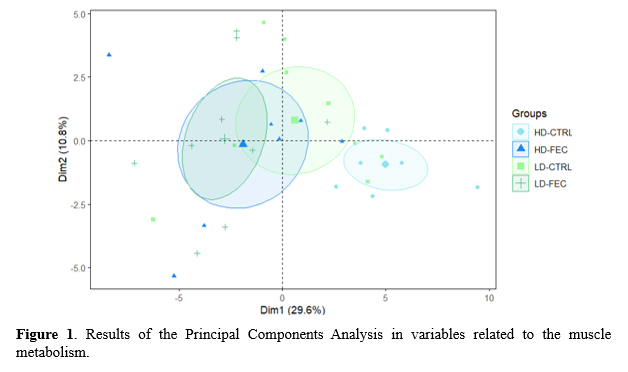A DIETARY PHYTOGENIC NUTRACEUTIC IMPROVES LIPID METABOLISM AND NUTRITIONAL PROFILE IN SEABASS Dicentrarchus labrax REARED AT HIGH STOCKING DENSITIES
Introduction
The stocking density is a fundamental aquaculture variable with a huge impact on fish growth performance and welfare. High stocking conditions normally trigger a stress response, and it has been shown that it can decrease flesh quality and fish nutritional value (Zhang et al., 2023) . The use of essential oils and phytogenic extracts as dietary additives have been reported to ameliorate fish nutritional quality in terms of fatty acid content (Sáez et al., 2024; Sutili et al., 2018) . This study assesses the effectiveness on lipid metabolism and nutritional profile of the phytogenic prototype with sedative properties, FishEase-C (FEC, TecnoVit-FARMFaes Ltd.), in the diet of Dicentrarchus labrax juveniles reared at different stocking conditions.
Materials and methods
Seabass juveniles (n = 438, wi = 74 ± 18 g, mean ± SD) were placed into 500 L-tanks and distributed in four different experimental groups in triplicate, defined as the combination of feeding (control or FEC diet , 1 mL per kg of feed) and initial stocking density (low density: 4 kg/m3 or high density: 18 kg/m3). Fish were maintained for 70 days under these conditions being weighted and measured periodically. At the end of the rearing period, animals were sampled. Liver was excised to assess changes in intermediary metabolism. Muscle biopsies were taken to assess lipid classes , fatty acid profile, and enzymatic activities from intermediary metabolism. The expression of some target genes of interest were determined in both tissues.
Results
At end of experimental period, fish almost doubled their weight, but no significant differences on growth parameters were observed between groups. T he use of the additive did not induce any negative consequences on fish. The carbohydrate and amino acid metabolism were not affected by the use of FEC prototype, nor by the stocking densities both at liver and muscle of seabass juveniles; however, some changes on lipid metabolism and nutritional composition were determined.
H igh stocking densities increased hepatic lipid metabolism and mobilization of triglycerides to be used as energy substrate , as it was shown by related enzymatic activities analysed (GPDH, ACL, HADH) and expression of target genes (apoa1 , fasn , lpl and ppar ). The use of the phytogenic prototype does not seem to ameliorate this response in liver.
In the muscle, the main lipid classes were not modified because of density conditions or addition of FEC, being triglycerides the most abundant one; however, t he use of FEC reduced muscular total lipid accumulation in animals reared at low density. In addition, GPDH muscle activity decreased by the supplementation of the FEC in fish both at high and low densities , suggesting that triglycerides are not being used as an energy substrate as much as in animals fed with control diet. The fatty acids profile was also modified by stocking densities and use of dietary FEC . This use increased total n-3 polyunsaturated fatty acids (PUFAs) at both densities . It was remarkable the docosahexaenoic acid (DHA) enhancement , at both low and high concentrations, in comparison with specimens fed with control diet . F ish reared at a low density with supplemented diet increased eicosapentaenoic acid (EPA) respect to control animals. Finally, the use of FEC attenuated the decrease in the DHA/EPA ratio induced by high stocking densities.
A multivariate analysis (PCA) was performed to unravel hidden patterns in muscle metabolism (Figure 1) , including enzymatic activities and fatty acids profiles. T he use of dietary FEC modulates the effect of high stocking density o n muscle metabolism, as a differentiation was observed between high stocking density control group and the other three experimental conditions. To conclude, these results support that dietary FEC phytogenic proto type can improve lipid management and nutritional profile in seabass, especially under chronic stress conditions by high stocking density.
Bibliography
Sáez, M. I., Galafat, A., Tapia Paniagua, S. T., Martos-Sitcha, J. A., Alarcón-López, F. J., & Martínez Moya, T. F. (2024). Feed Additives Based on N. gaditana and A. platensis Blend Improve Quality Parameters of Aquacultured Gilthead Seabream (Sparus aurata) Fresh Fillets. Fishes, 9(6). https://doi.org/10.3390/fishes9060205
Sutili, F. J., Gatlin, D. M., Heinzmann, B. M., & Baldisserotto, B. (2018). Plant essential oils as fish diet additives: benefits on fish health and stability in feed. In Reviews in Aquaculture (Vol. 10, Issue 3, pp. 716–726). Wiley-Blackwell. https://doi.org/10.1111/raq.12197
Zhang, T., Zhang, L., Yin, T., You, J., Liu, R., Huang, Q., Shi, L., Wang, L., Liao, T., Wang, W., & Ma, H. (2023). Recent understanding of stress response on muscle quality of fish: From the perspective of industrial chain. In Trends in Food Science and Technology (Vol. 140). Elsevier Ltd. https://doi.org/10.1016/j.tifs.2023.104145
Acknowledgments . Proyecto PISCIBIEN. Fondos Next Generation -EU. Ministerio de Agricultura, Pesca y Alimentación (MAPA). Plan de Recuperación, Transformación y Resiliencia (PRTR, RD685/2021).
